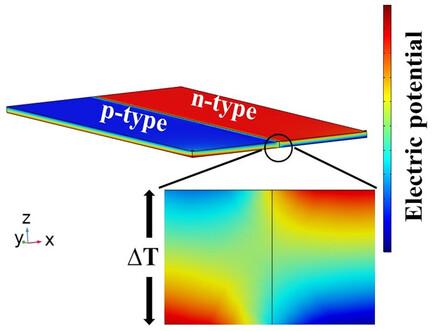Printed Lateral p–n Junction for Thermoelectric Generation
IF 11.1
Q1 MATERIALS SCIENCE, MULTIDISCIPLINARY
引用次数: 0
Abstract
Printed thermoelectric generators (TEGs) show promising potential for converting waste heat into useful electricity at a low cost but fall short of exhibiting a conversion efficiency anticipated from materials’ properties. The output power of conventionally printed TEGs in the “π-type” geometry suffers due to low thermal voltage and low current because of high thermal and electrical contact resistance, respectively. Herein, a type of printed p–n junction TEGs (PN-TEGs) as a possible remedy is explored. Two printed PN-TEGs with different thicknesses are fabricated using printed p-type Bi0.5Sb1.5Te3 and n-type Bi2Te2.7Se0.3 materials. The PN-TEGs show a promising way to minimize the influence of thermal and electrical resistance in printed TEGs. In the experimental and simulation results, the significant impact of PN-TEGs’ dimensions on their power outputs is revealed. Also, a conventional “π-type” printed TEG is fabricated and its performance is studied. The optimized PN-TEG with a single thermocouple yields ≈14 times higher power output density of 5.3 μW cm−2 at a ΔT of 25 K compared to “π-type” printed TEGs.

用于热发电的印刷侧 p-n 结
印刷热电发电机(TEG)在以低成本将废热转化为有用电能方面显示出巨大的潜力,但却无法达到根据材料特性所预期的转化效率。传统的 "π型 "印刷 TEG 的输出功率较低,原因是热电压和电流较低,分别是因为热阻和电接触电阻较大。在此,我们探讨了一种可作为补救措施的印刷 p-n 结 TEG(PN-TEG)。我们使用印刷的 p 型 Bi0.5Sb1.5Te3 和 n 型 Bi2Te2.7Se0.3 材料制作了两种不同厚度的印刷 PN-TEG 。PN-TEG 为最大限度地减少印刷 TEG 中热阻和电阻的影响提供了一种可行的方法。实验和模拟结果表明,PN-TEG 的尺寸对其功率输出有显著影响。此外,还制作了传统的 "π型 "印刷 TEG 并对其性能进行了研究。与 "π型 "印刷 TEG 相比,经过优化的 PN-TEG 带有单个热电偶,在 25 K 的 ΔT 条件下,功率输出密度≈14 倍,达到 5.3 μW cm-2。
本文章由计算机程序翻译,如有差异,请以英文原文为准。
求助全文
约1分钟内获得全文
求助全文
来源期刊
CiteScore
14.00
自引率
2.40%
发文量
0
期刊介绍:
Small Science is a premium multidisciplinary open access journal dedicated to publishing impactful research from all areas of nanoscience and nanotechnology. It features interdisciplinary original research and focused review articles on relevant topics. The journal covers design, characterization, mechanism, technology, and application of micro-/nanoscale structures and systems in various fields including physics, chemistry, materials science, engineering, environmental science, life science, biology, and medicine. It welcomes innovative interdisciplinary research and its readership includes professionals from academia and industry in fields such as chemistry, physics, materials science, biology, engineering, and environmental and analytical science. Small Science is indexed and abstracted in CAS, DOAJ, Clarivate Analytics, ProQuest Central, Publicly Available Content Database, Science Database, SCOPUS, and Web of Science.

 求助内容:
求助内容: 应助结果提醒方式:
应助结果提醒方式:


